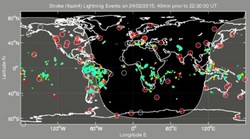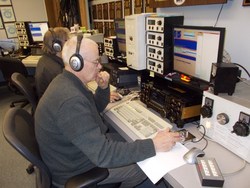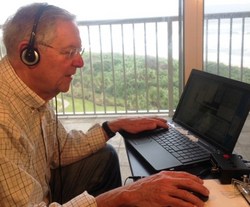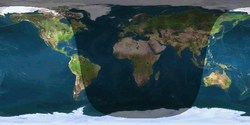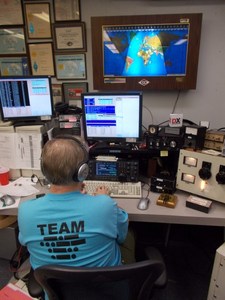 February 25, 2015 Editor: Ward Silver, NØAX | |||||||
IN THIS ISSUE
NEW HF OPERATORS - THINGS TO DO The third of the three North American QSO Parties is on this weekend - RTTY is the mode. Enjoy a Saturday of digital dabbling. The next weekend wraps up the ARRL DX contest with the phone edition - Technicians in particular will enjoy the worldwide action on 10 meters! BULLETINS Watch out for band edges on phone as it's easy to forget where your sidebands are - tune your SSB carrier frequency (what is displayed by the transceiver) no higher than 2.5 kHz below an upper band edge on USB (14.3475 and 21.4475 MHz, for example) and no lower than 2.5 kHz above the lower band edge on LSB (similarly, 7.1275 MHz). BUSTED QSOS The Radwav SkyPi-40 mentioned in the previous issue is a transmitter and not a transceiver. (Thanks, Bill WA7NWP) CONTEST SUMMARY Complete information for all contests follows the Conversation section February 28 - March 1
March 7-8
The Reverse Beacon Network's unending stream of radio observations from around the world has been noticed by the geophysics community as described in this story by the Earth & Space Science News. The detailed paper, "Ionospheric Sounding Using Real-Time Amateur Radio Reporting Networks" in the journal Space Weather is available online, as well. (Thanks, Dave KM3T and Pete N4ZR)
February 11, 2015 marks five years in space for NASA's Solar Dynamics Observatory, which provides incredibly detailed images of the whole Sun 24 hours a day. In honor of SODO's fifth anniversary, NASA has released a video showcasing highlights from the last five years of sun watching. Watch the movie to see giant clouds of solar material hurled out into space, the dance of giant loops hovering in the corona, and huge sunspots growing and shrinking on the Sun's surface. (Thanks, Rus K2UA) In related space science news, Sky and Telescope magazine reports in the March 2015 issue that contact has been lost with the STEREO B spacecraft. The STEREO mission includes two satellites, A (for Ahead) and B (for Behind), which image the Sun from two directions, providing three-dimensional views of solar phenomena, such as flares and coronal mass ejections that affect terrestrial radio communications. The February 2015 issue includes an article about another solar mission, the Interface Region Imaging Spectrograph (IRIS), which has discovered new types of behavior at small scales, dubbed "solar tornadoes" and "solar bombs," in the interface region between the chromospheres and corona. AMSAT Engineering is looking for hams interested in developing ground station equipment for future satellites. An inexpensive L-Band uplink converter is something that is of interest right now for LEO satellites as part of the recently approved technology funding. If you are interested in helping, please contact AMSAT Engineering by completing this form to tell Jerry Buxton, NØJY the Vice President of Engineering, how you can volunteer your time and skills to help AMSAT engineering build satellites and other required hardware/software. (From AMSAT News Bulletin ANS-046)
Hosted by the Mt Airy VHF Club Packrats, the 2015 Mid-Atlantic States VHF Conference will be held October 2-4 at the Holiday Inn in Bensalem, PA, near Philadelphia. Speakers and papers are being solicited right now, so contact Rick K1DS with your proposals. Dennis N6KI did a little online research and found that the radio operator of one of the Antonov 225 Russian aircraft - the largest in the world - is a ham; UY7MH, Gennady Antipov. CQ World Wide Director, Randy K5ZD, reports that John N2NC and a team of volunteers have now extended the CQ WW online database back to its beginnings in 1953. Given the amount of activity these days, it's hard to believe there were only 167 phone entries and 187 CW entries back then. Among other interesting stats, you can see the winning score every year for any combination of country/category. Website of the Week - The website of the week refers to all of the state QSO party websites out there! There are either individual state contests or regional contests that feature sometimes hard-to-work states for WAS-chasers. A tip to contest managers - add a simplified "How To Play In Our Contest" rule set right on the contest's first page so visitors can participate as easily as possible in these popular events. (Note - there is such a list online on WA7BNM's Contest Calendar website. Thanks to Carl KØTNT for asking!) WORD TO THE WISE Sad news was received Monday morning that competitor and station host Dich Pechie KB1H suffered a heart attack and died after participating in the ARRL DX CW contest through the weekend - a huge and unexpected loss to his family and the Yankee Clipper Contest Club community. Without inferring that the contest had anything to do with his demise, it is nevertheless a good idea to take care of yourself before, during, and after these marathon radio events in which we sit at our radios for hour after hour, often foregoing good nutrition, sleep, and exercise. James Brooks 9V1YC has produced a professional documentary on the 2014 WRTC event. Fast-paced and of the highest quality, this hour-long video makes for great viewing and the many interesting elements make this program well-suited for a club program attended by hams and non-hams alike.
The 4V1JR team operated in this past weekend's ARRL DX CW contest using a large broadcast facility currently under construction. The International Friendship Amateur Radio Club has put together a Facebook page showing how they erected a 180-foot tower completely by hand with a lot of people pulling the 340-lb sections all the way up the tower. Fortunately the project was a success and there were no injuries. CQ Haiti! (Thanks, Dale N3BNA) This upcoming March 5th webinar shows how the 2013 VK9CZ DXpedition to the Cocos (Keeling) Islands made 51 QSOs with U.S. Zone 5 (East Coast) on 80 meters. 21 of these QSOs - more than 40 percent - were with stations in Florida. This presentation discusses several possible propagation mechanisms for this gray line event, and concludes that propagation through the dark ionosphere, rather than along the gray line itself, was the responsible mechanism. Organic AM demodulation? It's possible as shown in this impromptu video which demonstrates you really can hear the grass growing. Well, burning maybe...(Thanks, Ken WBØQNA) The Voice of America's Edward R Murrow station is open for your visit by taking this online video tour. (Thanks, Art WØKG) The latest helmet-cam video presentation of a tower climber at work is fascinating, if a little scary. (Thanks, David WA1OUI) The package of results for the ARRL's September VHF Contest is now online, including the full results, line scores, results database, and log checking reports (LCRs). Log checking reports for the June VHF Contest have been posted, as well. (Thanks, ARRL Contest Branch Manager, Matt W1MSW) Preliminary results for the January CW and SSB North American QSO Parties are now posted on the NCJ website. Please check your category and QSO totals to make sure they appear to be accurate. If if something appears to be off or wrong contact the contest managers, Bill ACØW for SSB and Chris KL9A for CW, so it can corrected for the final results.
A team of operators mounted the first totally remote Multioperator Unlimited category effort in last weekend's ARRL DX CW contest at the station of K4VV. After putting in a lot of work to get the station ready, it turned out to be a good decision to go remote because weather made it impossible to be on-site. The team wound up with 4224 QSOs and 556 multipliers for a score of 7.040 Mpts. There weren't even any candy wrappers to pick up afterward! (Thanks, Bill W3UL) Pete N4ZR reports that Saturday and Sunday of ARRL DX CW ranked second and third among the busiest days on the RBN ever. While the system's new servers seemed to have performed very well, the RBN managers would like to receive by email any reports of anomalies such as delays. OPERATING TIP How important is accurate operating? Here's another example from the ARRL DX CW contest's post-even claimed score totals:
The net result is a lead by TI5W equal to about 7 minutes worth of operating. This new magnetic-sensitive foil, when applied to the skin, could give people a sense of "magnetoception". Maybe you could literally keep in touch with your ham radio friends? As contributor Dennis N6KI suggests, "Just think of all the possibilities!" The best way to secure a tower's grounding wire to its ground rod is by welding and the easiest way to make that weld is Erico's CADWELD Exothermic Welding process. Among the line of Erico products now carried by DX Engineering, the "one-shots" make copper-to-copper or copper-to-steel electrical connections without the need for outside heat or power sources. The result is a permanent bond that won't loosen or corrode over time, which is important for lightning protection.
Jeff ACØC recently upgraded his FTdx5000 radio and documented a very significant improvement in occupied transmit bandwidth - a major improvement over previous versions and another good step in the direction of cleaner transmit signals. Talk to your Yaesu dealer about installing the upgrade firmware package. (Thanks also, Jim K9YC) If you are rebuilding old radios and are looking for the right capacitors and other components, Hayseed Hamfest offers kits of components to save you a lot of shopping. You can then use the new-found spare time to make your own artisanal vacuum tubes! (Thanks, Kelly VE4XT and Tim K3HX) Owen VK2OMD (ex-VK1OD) published a lot of excellent technical material on a variety of topics but the site was off-line for a time. I'm pleased to report that Owen is back online! While grappling hooks are usually associated with movie-style prison breaks, rock-climbing, and various forms of pilferage, this High-Performance Grappling Hook from the Instructables project archives might have a home in your ham radio tower tool tote! Technical Web Site of the Week - Carl K9LA has a new post on his website, a review of one-way propagation. Carl has also created a history of his propagation columns for the now-discontinued WorldRadio and CQ Plus. (From ARRL Propagation Bulletin ARLP008) Our Unique Story At K3LR this weekend, I was part of the 15 meter team with Doug K1DG. From before dawn until way past dusk, we were each focused on a radio, trying to work every DX station that emitted so much as a call sign. We tried hard and knew well there were more stations "out there." With the headphones on and watching the grey line move across the map minute by minute, you catch yourself willing the band to open, thinking "Come on...just a little bit farther!"
With a big monobander stack, we sure attracted a lot of attention and occasionally I could hear a station (or several!) calling just under the noise, darting beneath the surface like shadowy radio fish that I could never quite land. I've been that shadow as have we all - so close and yet so far from that QSO you so badly want to complete. Some managed to catch a short swell, riding a wave of QSB, fluttery but strong enough for those few seconds to make it in the log, maybe never to be heard again. Other stations, I'm sure, tuned away but came back later and made the QSO with a better path between us. Experienced operators know well that when conditions are marginal or a band is just opening or closing, signals will come and go very quickly. A path may open and close in just a few seconds and you either make that QSO right then or you don't at all - there may be no "later." At sunrise, there were quite a few contacts during which I could literally hear the band opening as the Sun illuminated just a little bit more of the F layer with each passing second. Even though each QSO was very short, that was enough time to hear the world turn just a little bit more! Propagation is what makes ham radio totally unique among hobbies. Astronomers have their "good seeing" and certainly the upper atmosphere affects what they do, but to us the ionosphere (at least at HF and lower VHF) is life itself. And we can't see it at all! I'm sure that most of us share the experience, though, of looking up into the sky and sensing the signals flying back and forth above our heads. It gives you goose-pimples, doesn't it! Our "seeing" doesn't depend on whether you're using the latest product from the commercial labs or a home-built rig from your own workbench. When the power is switched on and the headphones come to life or a waterfall display starts cascading down the screen, each transceiver and antenna open a little window into a world that most people have never experienced. It's a unique story - and one we can all be proud to tell. 25 February through 10 March An expanded, downloadable version of QST's Contest Corral in PDF format is available. Check the sponsor's Web site for information on operating time restrictions and other instructions. HF CONTESTS CQ WW 160 Meter SSB--Phone, from Feb 27, 2200Z to Mar 1, 2200Z. Bands (MHz): 1.8. Exchange: RST and state/province or CQ zone. Logs due: 5 days. Rules UBA Contest--CW, from Feb 28, 1300Z to Mar 1, 1300Z. Bands (MHz): 3.5-28. Exchange: RS, serial, and ON province. Logs due: 2 weeks. Rules North American QSO Party RTTY--Digital, from Feb 28, 1800Z to Mar 1, 0600Z. Bands (MHz): 3.5-28. Exchange: Name and S/P/C. Logs due: 7 days. Rules North Carolina QSO Party--Phone,CW,Digital, from Mar 1, 1500Z to Mar 2, 0059Z. Bands (MHz): 3.5-28, 50, 144, CW 3.54,7.04,7.14,14.04,21.04,28.04,50.04,144.04; Phone 3.86,7.26,14.26,21.36,28.36,50.16,52.04(FM),144.26,146.58(FM) MHz. Exchange: NC county or S/P/C, RS(T) optional. Logs due: Mat 22. Rules OK1WC Memorial Contest--Phone,CW, from Mar 2, 1630Z to Mar 2, 1730Z. Bands (MHz): 3.5, 7. Weekly on Monday, see website for bands. Exchange: RS(T) and serial. Logs due: 5 days. Rules ARS Spartan Sprint--CW, from Mar 3, 0200Z to Mar 3, 0400Z. Bands (MHz): 3.5-28. Monthly on the first Monday evening local time. Exchange: RST, S/P/C, and power. Logs due: 2 days. Rules YL CW Party--CW, from Mar 3, 1900Z to Mar 3, 2100Z. Bands (MHz): 3.5. Exchange: RST, serial, if YL "YL," name. Logs due: Mar 31. Rules CWOps Weekly Mini-CWT Tests--CW, from Mar 4, 1100Z - See website. Multiple time periods. Bands (MHz): 1.8-28. Weekly on Wednesday, 28 to 38 kHz above band edge. Exchange: Name and member number or S/P/C. Logs due: 2 days. Rules John Rollins Memorial DX Contest--CW, from Mar 4, 2300Z - See website. Multiple time periods. Bands (MHz): 7,14. Exchange: RS, name, and S/P/C. Logs due: 4 weeks. Rules NS Weekly RTTY Sprint--Digital, from Mar 6, 0145Z to Mar 6, 0215Z. Bands (MHz): 3.5-14. Weekly on Thursday evenings local time. Exchange: Serial, name, and S/P/C. Logs due: 2 days. Rules NS Weekly Sprint--CW, from Mar 6, 0230Z to Mar 6, 0300Z. Bands (MHz): 1.8-14. Weekly on Thursday evenings local time. Exchange: Serial, name, and S/P/C. Logs due: 2 days. Rules ARRL Int'l Phone DX Contest--Phone, from Mar 7, 0000Z to Mar 8, 2359Z. Bands (MHz): 1.8-28. Exchange: RS and state, province, or power. Logs due: Apr 8. Rules Straight Key Weekend Sprintathon--CW, from Mar 7, 1200Z to Mar 7, 2359Z. Bands (MHz): 1.8-28, 50. Exchange: RST, QTH, name, member nr if member. Logs due: 5 days. Rules Open Ukraine RTTY Championship--Digital, from Mar 7, 1800Z - See website. Multiple time periods. Bands (MHz): 1.8-28. Exchange: Regional abbreviation and serial. Logs due: Apr 30. Rules VHF+ CONTESTS Worldwide EME Contest--Phone,CW, from Feb 28, 0000Z to Mar 1, 2400Z. Bands (MHz): 2.3G. Exchange: TMO/RS(T) and "R". Logs due: Jun 15. Rules North Carolina QSO Party--Phone,CW,Digital, from Mar 1, 1500Z to Mar 2, 0059Z. Bands (MHz): 3.5-28, 50, 144, CW 3.54,7.04,7.14,14.04,21.04,28.04,50.04,144.04; Phone 3.86,7.26,14.26,21.36,28.36,50.16,52.04(FM),144.26,146.58(FM) MHz. Exchange: NC county or S/P/C, RS(T) optional. Logs due: Mat 22. Rules Straight Key Weekend Sprintathon--CW, from Mar 7, 1200Z to Mar 7, 2359Z. Bands (MHz): 1.8-28, 50. Exchange: RST, QTH, name, member nr if member. Logs due: 5 days. Rules LOG DUE DATES 25 February through 10 March
ARRL Information Click here to advertise in this newsletter, space subject to availability. Your One-Stop Resource for Amateur Radio News and Information ARRL membership includes QST, Amateur Radio's most popular and informative journal, delivered to your mailbox each month. Subscribe to NCJ - the National Contest Journal. Published bimonthly, features articles by top contesters, letters, hints, statistics, scores, NA Sprint and QSO Parties. Subscribe to QEX - A Forum for Communications Experimenters. Published bimonthly, features technical articles, construction projects, columns and other items of interest to radio amateurs and communications professionals. Free of charge to ARRL members: Subscribe to The ARRL Letter (weekly digest of news and information), the ARES E-Letter (monthly public service and emergency communications news), Division and Section news -- and much more! ARRL offers a wide array of products to enhance your enjoyment of Amateur Radio. Visit the site often for new publications, specials and sales. Donate to the fund of your choice -- support programs not funded by member dues! Reprint permission can be obtained by sending email to permission@arrl.org with a description of the material and the reprint publication. ACKNOWLEDGEMENTS ARRL Contest Update wishes to acknowledge information from WA7BNM's Contest Calendar and SM3CER's Contest Calendar.
| |||||||
